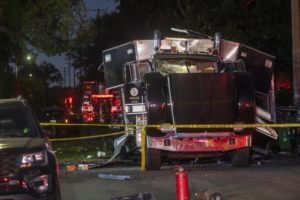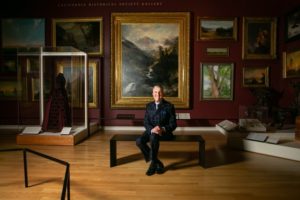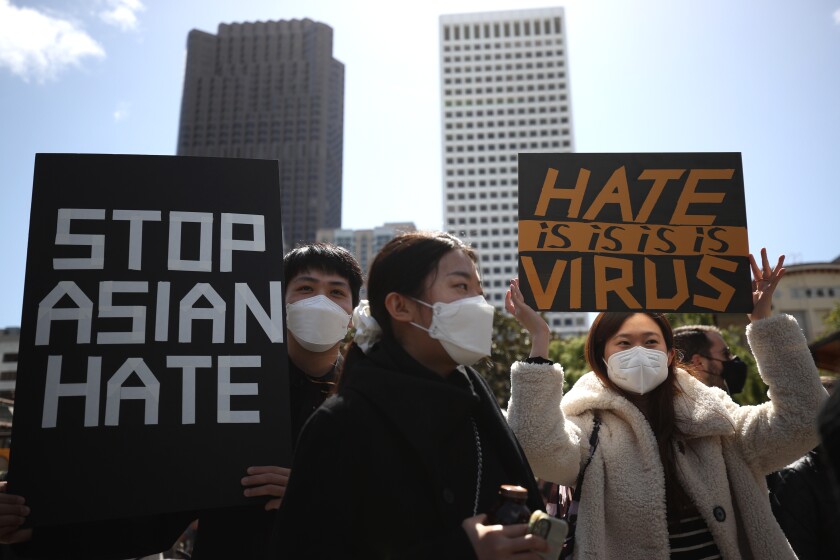| Good morning, and welcome to the Essential California newsletter. It’s Thursday, July 1. I’m Justin Ray.
A report released Wednesday by the state attorney general’s office unveils troubling numbers about hate crimes in California, Los Angeles Times staff writer Anh Do reports.
Hate crimes in the state have increased 31% last year, with attacks against Asian Americans up by 107%, the report said. Anti-Asian hate crimes skyrocketed during March and April 2020, as stay-at-home orders forced by the COVID-19 pandemic were implemented.
There were 89 hate crimes reported against Asian Americans in California last year, compared with 43 in 2019. A hate crime is defined as a criminal act motivated at least in part by a characteristic such as race, gender or religion.
A report released in March by Stop AAPI Hate documented 3,795 racially motivated attacks against Asian Americans from March 2020 to February 2021 across America. But they noted that these numbers are probably an undercount, because many were not reported to the group. About 68% of the anti-Asian attacks documented were verbal harassment, 21% were shunning and 11% were physical assaults. More than two-thirds were reported by women.
Discussions around anti-Asian violence escalated earlier this year after a gunman killed eight people, including six women of Asian descent, at spas in the Atlanta area. Just last month, the Los Angeles County Metropolitan Transportation Authority said an Asian rider was attacked on a Metro train.
As The Times has reported before, the roots of anti-Asian violence can be found in California history. That’s because of events such as the lynchings of Chinese residents in Los Angeles in 1871, or the state’s championing of the Chinese Exclusion Act. There was also the incarceration of Japanese residents, including U.S. citizens, in prison camps during World War II; many were in California.
In March, The Times published a story that speaks to the Asian American experience at this fraught moment in America. Some are frustrated that the issue doesn’t receive enough attention from the media.
“I have felt almost gaslit by the lack of coverage,” one source said after the Atlanta-area massacre. “I’ve been sitting here all day wondering, ‘Why now? Why today?’ We’ve been talking about this for a year. Why does it take these Asian women being slaughtered for people to suddenly pay attention?”
You can find more coverage of anti-Asian racism here.
And now, here’s what’s happening across California.
Note: Some of the sites we link to may limit the number of stories you can access without subscribing.
.
.
Ads by: Memento Maxima Digital Marketing
@[email protected]
SPACE RESERVE FOR ADVERTISEMENT
.
L.A. STORIES
An explosion rocked South Los Angeles during LAPD detonation of illegal fireworks. The blast in a residential neighborhood damaged buildings and injured at least 17 people, including police officers, as a bomb squad attempted to safely detonate improvised explosive devices that had been seized from a home along with thousands of pounds of illegal fireworks. Los Angeles Times
.
An LAPD bomb squad truck was severely damaged in the explosion. (Francine Orr / Los Angeles Times)
A woman accused Dodgers pitcher Trevor Bauer of assaulting her during two encounters that shifted from consensual to nonconsensual, according to a restraining order request filed this week in Los Angeles County. The restraining order request includes her account of the two nights she states she spent with Bauer, text messages and pictures of bruises on her body. Bauer, through his agent, denies he assaulted the woman and says the sexual relationship was consensual. The agent said Bauer is cooperating with the investigation. Los Angeles Times
L.A.’s biggest — and smelliest — corpse flower is about to bloom. Plant lovers will once again be able to visit the corpse flower at the Huntington. Last year’s corpse flower bloom was livestreamed on YouTube, but this year will be different since most museums and botanical gardens in Los Angeles have reopened to full capacity. But this year’s tropical plant, affectionately called “Stankosaurus Rex,” is not only unique for its accessibility, it is the biggest specimen in Huntington history. Los Angeles Times
In an abrupt shift, L.A. backs a new measure to restrict homeless encampments. The Los Angeles City Council voted Tuesday to draft new rules barring homeless people from camping near schools, parks, libraries and other sensitive facilities. On a 12-3 vote, council members asked the city’s lawyers to draw up an ordinance prohibiting sleeping, lying and storing possessions near public facilities including public schools and homeless shelters. It also would bar tents and encampments from blocking sidewalks in ways that prevent people in wheelchairs from traveling on them, in violation of the federal Americans With Disabilities Act. Los Angeles Times
‘The Times’ podcast
Our new weekday podcast, hosted by columnist Gustavo Arellano, takes listeners beyond the headlines. Subscribe on Apple Podcasts and follow on Spotify.
POLITICS AND GOVERNMENT
The San Jose City Council has passed a series of new proposals to address gun violence. The plan will require gun owners to carry liability insurance and pay a fee to cover taxpayer costs associated with gun violence. The vote comes after nine people were killed in a mass shooting at a railyard in San Jose in May. The new ordinances are expected to be challenged in court by gun advocates. It isn’t clear when these regulations will go into effect. KRON4
California advances bill to decriminalize psychedelic substances. On Tuesday, the state moved closer to decriminalizing psychedelics. A bill would allow those 21 and older to possess for personal use and “social sharing” psilocybin, the hallucinogenic component in what are called “magic mushrooms.” It also covers dimethyltryptamine (DMT), ibogaine, mescaline excluding peyote, and others. The bill was amended to remove ketamine from the list; opponents said the chemical could be used as a date-rape drug. The bill now heads to the health committee before it can go to the full Assembly. Associated Press
Support our journalism
Subscribe to the Los Angeles Times.
HEALTH AND THE ENVIRONMENT
Fake plastic trees. Southern California is blanketed by cell tower trees, Times reporter Daniel Miller says. They are found beside freeways and in other in-between spaces in cities like Los Angeles. “The demand for calls that never drop and videos that always stream is fueling the growth of these structures, whose fake foliage is meant to obscure the rectangular antennas clustered near their tops,” he writes. Miller explains the law that led to these peculiar towers and how they are built. Los Angeles Times
.
Ads by: Memento Maxima Digital Marketing
@[email protected]
SPACE RESERVE FOR ADVERTISEMENT
.
CALIFORNIA CULTURE
The Times published an exit interview with Rick West, retired director of the Autry Museum of the American West. He talks about how the Autry and Smithsonian’s National Museum of the American Indian in Washington, D.C., where he served as founding director, have been rethinking how to engage with Indigenous communities through resources and study centers that include ceremonial space. “Seeing Native material in a museum is inherently a false experience. We never put things on walls. Every object you see is associated with life and living in a Native community. You can never make a genuine gallery space in that way,” West said. Los Angeles Times
.
Rick West sits before landscapes in a dramatically illuminated gallery (Jason Armond / Los Angeles Times)
Day Trip music festival relocates again. Only days before the inaugural Day Trip music festival, concert producer Insomniac announced another venue change and promised to refund ticket holders who can’t get to the new site. A permit issue has forced the festival out of Inglewood. The festival will now happen July3 and 4 at the NOS Event Center in San Bernardino. The event was originally set to take place at the Los Angeles Waterfront in San Pedro. San Bernardino Sun
Free online games
Get our free daily crossword puzzle, sudoku, word search and arcade games in our new game center at latimes.com/games.
CALIFORNIA ALMANAC
Los Angeles: Sunny, 82. San Diego: Cloudy, 74. San Francisco: Cloudy, 65. Fresno: Sunny, 78. Sacramento: Sunny, 91.
AND FINALLY
Today’s California memory is from Susan Sanchez:
Growing up in the Bay Area, it was more of a sleepy collection of small cities, pre-tech, with “the city,” aka San Francisco, as this marvelous place you went to for special occasions. The suburbs where I grew up lacked much excitement, so when I noticed a giant blimp flying low in the sky one afternoon, I yelled to my mom and sister, “Let’s follow it!” So we piled into the Peugeot station wagon to trail the blimp. It turned out it was Mr. Pibb dressed in an aviator outfit, and upon landing in an elementary school field, he leaped out and handed out free Mr. Pibb soda from a truck to everyone. He had a long white scarf on and wild ginger hair blowing in the summer breeze.
If you have a memory or story about the Golden State, share it with us. (Please keep your story to 100 words.)
Please let us know what we can do to make this newsletter more useful to you. Send comments to [email protected].
.
Ads by: Memento Maxima Digital Marketing
@[email protected]
SPACE RESERVE FOR ADVERTISEMENT
|



